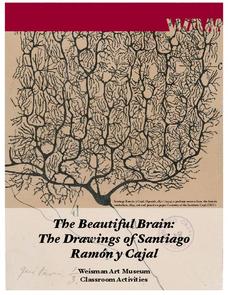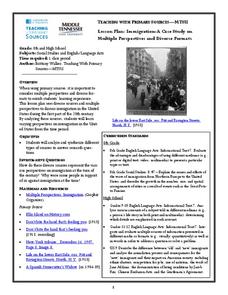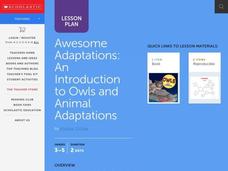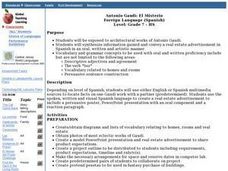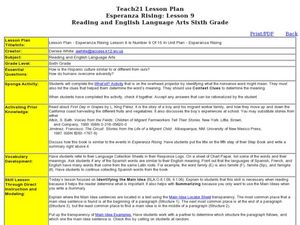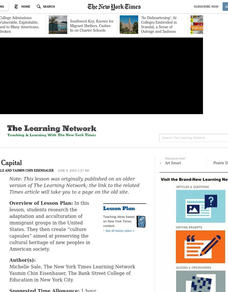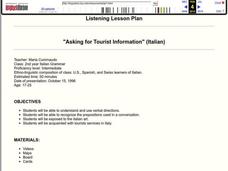Curated OER
Where In The World?
Students identify the goods and services from the United States and Mexico. Using postage stamps, they describe the various images they see and place them into categories. They use those categories to determine what is important in...
Curated OER
Como lo veo
Students pretend there is breaking news in their local area. After reading other eye-witness accounts, they identify the components of an article of this type. They write their own eye-witness account, share them with the class and...
Curated OER
Recuerdos De Mis Vacaciones Mexicanas.
Young scholars are presented with five items found in a suitcase to reflect upon the experience of a Mexican vacation. They use realia to produce a journal entry about one of the objects and its uses. The item is then brought to the...
University of Minnesota
Beautiful Brain: Strangest Dream
Do words change or add meaning or interest to a work of art? The final lesson in a four-part series on the beautiful brain as a work of art focuses on art analysis. Scholars write a story about exploring art from the inside. Reflections...
NASA
Let's Investigate Mars
Take your science class on a hypothetical field trip to Mars with an engaging astronomy instructional activity. After first learning about NASA's Mars rover missions, young scientists plan their own scientific investigations of Earth's...
Middle Tennessee State University
Lesson Plan: Immigration: A Case Study on Multiple Perspectives and Diverse Formats
As part of a case study of U.S. immigration during the first part of the 20th century, class members examine a variety of primary sources that present multiple perspectives of the responses of those in favor of immigration and those...
Scholastic
Awesome Adaptations
Engaged learners discover how an owl beak works and how animals adapt to their environment. This task is part one of a three-part series.
Curated OER
The Poetry of Chinese Immigration
Numerous people from China immigrated to the US during the era of industrialization and expansion. Provide your class with a glimpse into the life of a Chinese immigrant through the poetry they left behind. They then compose a poem of...
PBS
The Media and the War: The Penny Press, Walt Whitman and the War
The Mexican-American war marked a significant moment in United States history, as well as in the history of American media. The mid-nineteenth century saw the introduction of the Penny Press, which provided many American citizens with...
Curated OER
Call to Arms: A Service Project
Sick of selling candy and washing cars? How about hosting a Digital Day or a Learning Lunch? The suggestions here make fund raising fun and rewarding. Raise money to preserve important maps and other primary source documents.
Curated OER
Fun with Food: Hola Jalapeno
Students engage in an at-home lesson on language. It contains components that address Adult Education/ESOL, and age appropriate activities for Toddler, Preschool and School aged Students. Adults reinforce steps to prepare tacos in...
Curated OER
Antonio Gaud¿¿: El Misterio
Students examine the architecture of Antonio Gaudi. Using the Internet, they research his life and summarize the information. They create a real estate advertisement in Spanish. Using new vocabulary, they use descriptive adjectives and...
Curated OER
Expanding Map Vocabulary
First graders name the vocabulary words in Navajo, Ute and Spanish for the cardinal directions.
Curated OER
Visual Vocabulary
Students use context clues to determine an understanding for vocabulary words in texts. In this vocabulary lesson plan, students recognize linguistic features in their readings to help them to figure out words.
Curated OER
Library Curriculum: What Would a Wonderful Library Be Like?
Second graders complete a KWL chart about libraries. They create a book using writing patterns of a particular author. Students decide criteria for awarding the Second Grade Librarian Award to books in the classroom library, and use a...
Curated OER
Esperanza Rising: Lesson 9
Sixth graders explore culture by reading a book with classmates. In this Hispanic history lesson, 6th graders read the story First Day in Grapes, and discuss the tough lives of migrant workers. Students answer study questions after the...
Curated OER
Cultural Capital
Students research the adaptation and acculturation of immigrant groups in the United States. They create culture capsules aimed at preserving the cultural heritage of new peoples in American society.
Curated OER
Estamos en la granja (We are on the farm)
Students receive a blank farm scene and a baggie of animal cutouts with names on them. They sit back to back so they cannot see each other's farm scene, then place 3-4 animals on their farm scene. They ask each other if their animal is...
Curated OER
The Roadmap to the Jewish Golden Age of Spain
Students discover, through analysis of media and of primary source historical documents, how Jews achieved high levels of assimilation and acceptance under Islamic rule during the Golden Age of Spain, from the tenth to the twelfth century.
Curated OER
Spicy Hot Colors
Second graders investigate the book Spicy Hot Colors. In this colors lesson, 2nd graders experiment mixing paint and creating different colors. Students make text to world connections and record their responses and draw pictures.
Curated OER
Create Your Own Ad
Young scholars examine the elements of advertising. They analyze the format and structure of advertisements. They develop awareness of advertising techniques and explain that media messages and products are composed of a series of...
Curated OER
Is the Media Part of the Story?
Students discuss the role of the media in public opinion. They use the internet to research when the media has had an impact on war. They write an essay about their research and any conclusions they have made.
Curated OER
"Asking for Tourist Information" (Italian)
Students explain and use verbal directions, recognize the prepositions used in a conversation, explore Italian art, and acquaint themselves with tourist services in Italy.
Curated OER
Preliminary information
High schoolers develop reading strategies: inferring meaning from context. They work together in order to negotiate the meaning of the various vocabulary items. Students predict the personality of the main character in each of the books.





